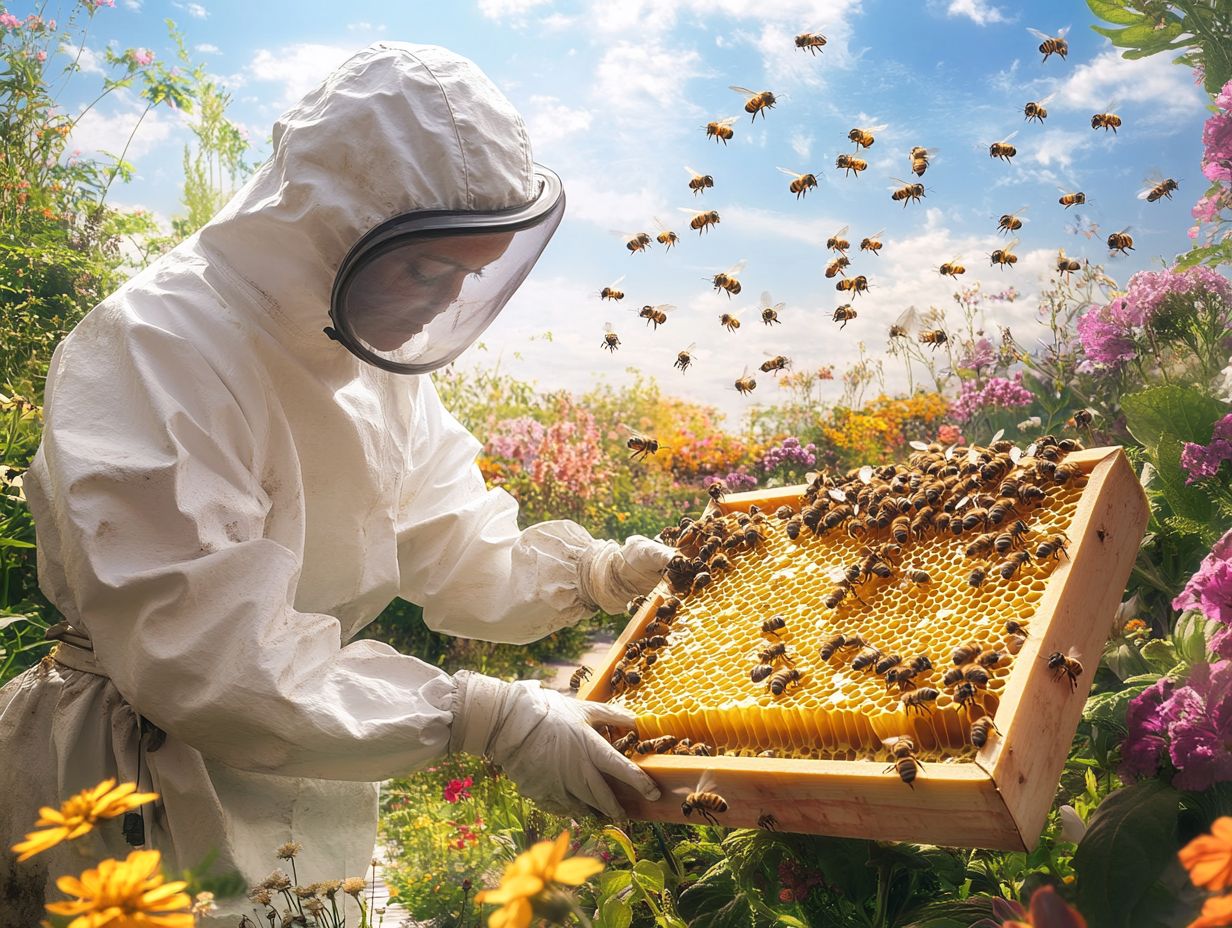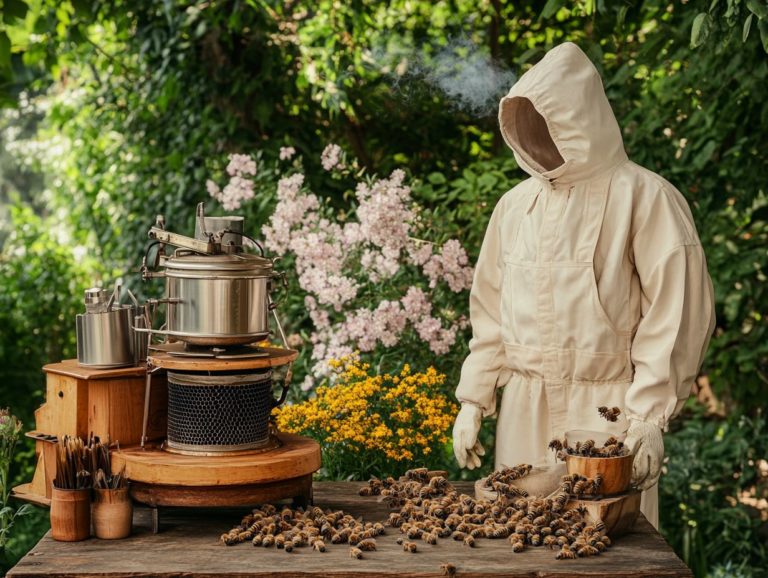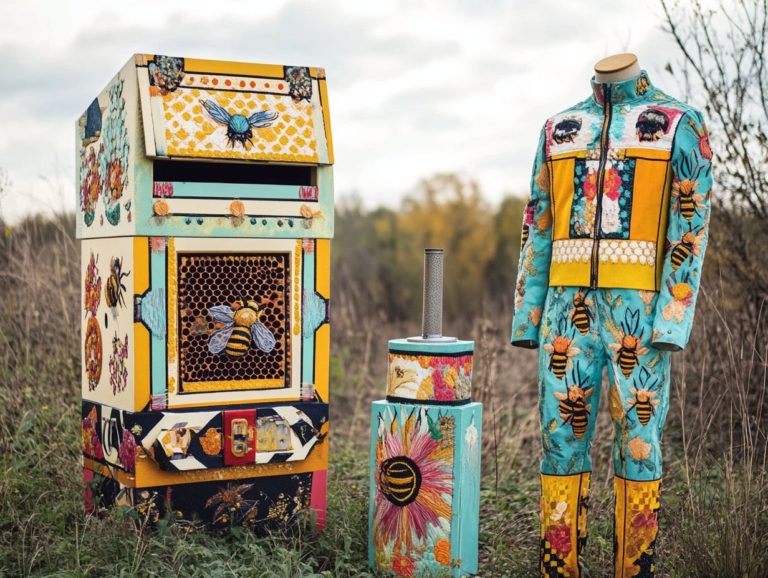Maintaining Bee Health with Proper Equipment
Beekeeping is not just a hobby; it’s a rewarding endeavor that requires your focus on the health of your bees. The health of your bees largely depends on the quality and upkeep of your equipment.
Get ready to discover the essential tools every beekeeper needs! This article highlights the vital instruments that play a crucial role in maintaining bee health and what factors you should weigh when selecting the right gear for your specific needs.
You’ll also find insights into the best brands, effective maintenance techniques, and practical troubleshooting tips for common issues that may arise.
Immerse yourself in this knowledge to ensure your bees flourish in a thriving, well-managed environment!
Contents
- Key Takeaways:
- The Importance of Proper Equipment for Bee Health
- Choosing the Right Equipment for Your Beekeeping Needs
- Proper Maintenance and Cleaning of Beekeeping Equipment
- Common Issues and Troubleshooting for Beekeeping Equipment
- Frequently Asked Questions
- What is the importance of maintaining bee health with proper equipment?
- What is Essential Equipment for Maintaining Bee Health?
- How Often Should Beekeeping Equipment Be Cleaned?
- What Should You Do if Equipment is Damaged?
- What are the Guidelines for Maintaining Bee Health?
- Can Improper Equipment Harm Bee Health?
Key Takeaways:
Here are the key takeaways to keep your bees healthy and thriving:
The Importance of Proper Equipment for Bee Health
Proper equipment is essential for maintaining the health and productivity of honey bees. This is particularly important in California’s vibrant agricultural landscape, where beekeepers play a pivotal role in facilitating successful pollination.
The right beekeeping tools bolster the well-being of the colony and significantly impact their capacity to thrive and produce honey. Every beekeeper should act quickly to ensure their bees are safe from diseases like Colony Collapse Disorder and manage pests such as Varroa mites, which can wreak havoc on colonies if left unchecked.
Essential Equipment Every Beekeeper Should Have
Essential beekeeping equipment is vital for maintaining healthy colonies of honey bees, which are crucial for successful pollination and agricultural productivity. This equipment includes hive boxes, protective gear, and monitoring tools designed to help you manage your colonies effectively.
Each piece serves a specific purpose, enhancing your overall operation. For example, hive boxes provide a structured home for the bees to thrive and store honey. Protective gear shields you from potential stings during necessary hive inspections.
Monitoring tools, like hive scales and mite testers, allow you to observe colony health, enabling proactive management. Smokers help by calming the bees during handling, reducing stress and ensuring a smooth workflow.
Collectively, these elements safeguard the well-being of the bees and promote robust pollination, which is essential for many crops and natural ecosystems.
How Do These Tools Help Maintain Bee Health?
The right beekeeping equipment is essential for maintaining the health of your honey bees, allowing you to effectively monitor and manage your colonies. With the right tools, you can swiftly detect and address issues like Varroa mites and diseases such as Nosema ceranae, leading to healthier, more productive colonies.
Regular hive inspections are crucial, as they enable early identification of health issues and confirm that your colony is thriving. Providing pollen substitutes can support your bees’ nutritional needs, especially during lean times when natural forage is hard to find.
Implementing effective pest management practices, such as using screened bottom boards and appropriate mite treatments, is vital to protect your hive from common threats. By utilizing these tools, you create a nurturing environment that fosters robust bee populations and enhances their resilience against various challenges.
Choosing the Right Equipment for Your Beekeeping Needs
Selecting the appropriate equipment for your beekeeping needs is vital for running a prosperous apiculture operation, particularly in regions like California, where honey bees play a key role in agricultural pollination.
Consider several factors, such as the type of hive equipment you’ll use, how to effectively monitor your hives for health issues, and the importance of adhering to Best Management Practices that prioritize the well-being of your colonies.
Don’t wait! Invest in the right equipment today to protect and nurture your bees.
What Factors Should Be Considered When Choosing Beekeeping Equipment?
Choosing the right beekeeping equipment is crucial. It impacts your bees’ health and your operation’s success. Consider the following key factors:
- Type of hive: The type you select can greatly influence your hive’s productivity.
- Monitoring systems: Implement effective systems to keep track of your bees’ health.
- Pest control measures: Focus specifically on Varroa mites, which can devastate bee populations.
The local climate is also critical. Different bee species thrive under various temperature and humidity conditions. Understanding your region’s pollination requirements helps you decide on hive placement and equipment, ensuring your colonies have ample forage.
Don’t overlook financial considerations. While investing in high-quality materials may seem expensive, it can lead to long-term savings through increased honey production and lower disease management costs. By weighing these factors thoughtfully, you can create a sustainable and productive environment for your bees.
What Are the Best Brands for Beekeeping Equipment?
Selecting leading brands for beekeeping equipment is essential for your investment. Quality products enhance the health and productivity of your honey bees. Well-regarded brands adhere to Best Management Practices and offer a range of hive equipment tailored to your specific needs.
- Hives: Essential for housing your bees.
- Protective gear: Keeps you safe while working with bees.
- Honey extraction equipment: Necessary for harvesting honey.
These reputable brands prioritize innovation and sustainability. They often use durable materials that withstand various weather conditions, ensuring your equipment lasts. Many companies also educate beekeepers through workshops and online resources, providing you with the knowledge to maintain healthy colonies.
Consider brands like Mann Lake and Brushy Mountain, both known for their exceptional customer service and extensive selection.
Proper Maintenance and Cleaning of Beekeeping Equipment
Proper maintenance and cleaning of your beekeeping equipment are vital. They have a direct impact on the health and sustainability of your honey bee colonies, which are essential for successful pollination.
Regular upkeep prevents diseases like Colony Collapse Disorder and manages pests such as Varroa mites, ensuring your colonies remain healthy and vibrant.
Why Is It Important to Clean and Maintain Beekeeping Equipment?
Regular cleaning and maintenance of your equipment is essential. This keeps your bees healthy and productive. Neglecting this responsibility risks spreading pathogens and infestations, like Varroa mites, devastating bee populations.
Without a maintenance schedule, harmful bacteria thrive, and pests invade your hives. For instance, poor sanitation can lead to fecal matter buildup and leftover honey residues, attracting ants and other pests. This weakens your bees’ defenses and can lead to diseases like American foulbrood or nosema.
Incorporating effective cleaning methods, such as a vinegar and water mixture for disinfection, along with a structured maintenance timetable—ideally every few weeks—can significantly reduce these risks. By prioritizing these practices, you enhance the health of your colonies and positively contribute to the broader ecosystem.
What Are the Steps for Properly Cleaning and Maintaining Beekeeping Equipment?
Following a systematic approach to cleaning and maintaining your beekeeping equipment is crucial to keeping your honey bees healthy and safe from potential threats like pests and diseases. By using the right cleaning steps and maintenance routines, you can significantly enhance successful pollination and overall hive’s productivity.
To start, gather all the necessary supplies, such as brushes, soapy water, and sanitizers specifically designed for beekeeping tools. Inspect your hive boxes for any signs of wear or damage, as these issues could compromise your bees’ safety.
Next, carefully remove the frames and clean them with a gentle brush to eliminate debris and wax buildup. Rinse your tools thoroughly to remove any leftover cleaning agents. Then, air-dry them completely to prevent moisture accumulation.
This meticulous routine not only ensures the longevity of your equipment but also fosters a healthier environment for the hive, ultimately benefiting the entire ecosystem.
Common Issues and Troubleshooting for Beekeeping Equipment
Grasping the common issues and troubleshooting techniques related to beekeeping equipment is crucial for you as a beekeeper. This knowledge directly influences the health of your honey bees and the overall success of your operations.
Mastering effective troubleshooting allows you to tackle potential problems like pest infestations and equipment malfunctions. These challenges may arise throughout your beekeeping journey.
How to Identify and Fix Common Issues with Beekeeping Equipment?
Identifying and addressing common issues with your beekeeping equipment is essential for ensuring the health of your honey bees and the efficiency of your operation. By being vigilant and recognizing symptoms of problems early on, you can take proactive steps to mitigate issues like pest infestations or equipment malfunctions.
Effective monitoring is key. For example, keeping an eye out for signs of excessive moisture in your hives can prevent mold growth, which can pose serious risks to your colony’s health. Also, watch for unusual bee behaviors, such as heightened aggression or a decrease in foraging activity. These can signal underlying issues that need attention.
Regularly inspecting your frames for wear and ensuring your screens are free of debris will contribute to a thriving apiary, the place where beehives are kept. You can maintain a clean workspace easily. Schedule routine equipment checks to boost your tools’ lifespan.
When Should You Replace Beekeeping Equipment?
Knowing when to replace your beekeeping equipment is essential for safeguarding the health of your honey bees and ensuring your operation runs seamlessly. By conducting frequent inspections and assessments, you can determine the lifespan of your equipment and recognize when a replacement is necessary.
Regular checks on components like hive boxes and frames are crucial. Wear and tear can significantly impact both the efficiency of your bees and the overall yield of honey. Always keep an eye out for signs of damage, such as cracks, warping, or rust. Neglect can lead to serious issues, as these problems can harbor pests and diseases that threaten bee health. Outdated or inefficient equipment can induce stress within the hive, ultimately affecting productivity.
Establishing a maintenance schedule for thorough inspections and timely replacements is a prudent strategy for maintaining a thriving environment for your bees.
Frequently Asked Questions
What is the importance of maintaining bee health with proper equipment?
Maintaining bee health with proper equipment is crucial for the overall well-being and productivity of a bee colony. Proper equipment helps to provide a safe and suitable environment for the bees, allowing them to thrive and produce honey.
Make sure to inspect your equipment regularly to ensure the health of your bees!
What is Essential Equipment for Maintaining Bee Health?
Essential equipment for maintaining bee health includes beehives, frames, protective clothing, a hive tool (used for opening hives), a smoker, and a brush. These tools help you manage the bee colony, inspect the hive, and harvest honey.
How Often Should Beekeeping Equipment Be Cleaned?
Clean your beekeeping equipment after every use. This practice prevents the spread of diseases and ensures the equipment is in top shape for the bees.
What Should You Do if Equipment is Damaged?
If you find damaged equipment, act quickly to repair or replace it. Damaged tools can threaten your bees and lower the quality of honey.
What are the Guidelines for Maintaining Bee Health?
Follow specific guidelines to maintain bee health. Keep your equipment clean, regularly inspect for damage, and use proper beekeeping techniques.
Can Improper Equipment Harm Bee Health?
Yes, using improper equipment can harm bee health. It may spread diseases, damage hives, and even endanger the bees themselves.









